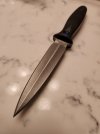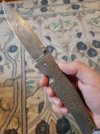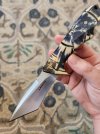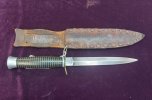- Joined
- Feb 2, 2024
- Messages
- 343
From way-back-when I've been fascinated by double-edged knives/daggers and their cousins the false-edged fighting knives. I think it may have started when my father gave me a knife he had fashioned while in the European Theatre during WWII. Let's begin with the one that started it all:

While in the European Theater of Operations, 1944-45, my father made this from a crosscut saw blade. (He was a mechanic in an armored field artillery unit, so he occasionally had some time.) The handle is melted-and-poured aluminum. The "jewel" is a piece of toothbrush handle, and there's one on the other side. When he brought it home, it was unsharpened on either side. Before he gave it to me, he sharpened one edge. He was adamant that it remain single-edged, but that's another story.
In the next several pics are presented most -- but not all -- of my collection of double- and false-edged fighting knives.
An accidental newest/oldest pairing. The top knife is one I recently acquired. Made in Japan, with a custom sheath by @wvtracker14 . The bottom knife is a WWII handmade knife with the owner's name, "Justin", stamped into the blade.
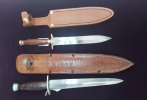
The second pair is interesting. The top knife is difficult to date. It sorta-kinda resembles a Randall Model 2, but several things suggest a Vietnam-era beginning. The second knife is clearly a WWII "theater knife". The blade and sheath are clearly from Sheffield England, but the handle is made up of aluminum, lexan, and other rings. Well done, I think.
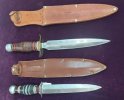
This next pairing is clearly Vietnam-era, and both are from the same manufacturer. They are Valor "boot knives" though the larger could easily be a belt knife. Interestingly, these can be difficult to find in such good condition.
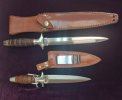
Here's another "odd couple". The upper knife is clearly a well-made WWII theater knife. My father made one that strongly resembles this knife, but it was stolen from his parents' house, along with several others, when I was about 8. To be quite clear, this is NOT the one he made.
The bottom knife was converted from a USGI M7 bayonet blade. The conversion, and the sheath, were done by a pair of brothers. I have about 5 more of their knifes.
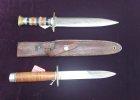
Now we come to an extremely interesting group. The next four knives either ARE, or were converted to resemble, the venerable M3 fighting knife.
The top one in this picture actually is (or was) an M3 that someone converted into a true double-edged knife. Sorry for the obscuring glare in the pic. It is almost impossible to get a decent picture of the blade.
The bottom one, I think, is more interesting. It was converted from a WWII leather-handled M4 bayonet. Take note that the latching mechanism has been removed and the gaps filled with metal. The modified guard is interesting also.
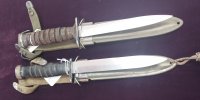
In the next pic are another interesting pair. The top one is an M3 converted from an M7 bayonet, simply by replacing the guard and pommel.
The knife in the bottom pic is much more interesting. It was also made from a WWII M4 bayonet. The pommel latching mechanism has been removed, but otherwise the pommel is intact. The guard, on the other hand, was made by cutting the bayonet ring and "curling" it down into an almost-solid bit.
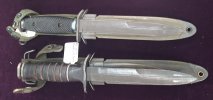
Now, finally, here's a very sentimental favorite. Any boy who grew up in the late 50's and early 60's will remember ads for this knife in -- every -- danged -- magazine -- that was about, or featured, outdoorsmanship. I never had one, but two of my cousins -- boys about 3 years apart -- did. Every time I'd visit, their knife would be something we'd dig out and play with. It came from Germany and, these days, can be very difficult to find.
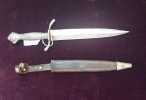
Well, that's it for now. My other double-edged knives are in their respective collections: Gerber, Randall, and what-have-you.

While in the European Theater of Operations, 1944-45, my father made this from a crosscut saw blade. (He was a mechanic in an armored field artillery unit, so he occasionally had some time.) The handle is melted-and-poured aluminum. The "jewel" is a piece of toothbrush handle, and there's one on the other side. When he brought it home, it was unsharpened on either side. Before he gave it to me, he sharpened one edge. He was adamant that it remain single-edged, but that's another story.
In the next several pics are presented most -- but not all -- of my collection of double- and false-edged fighting knives.
An accidental newest/oldest pairing. The top knife is one I recently acquired. Made in Japan, with a custom sheath by @wvtracker14 . The bottom knife is a WWII handmade knife with the owner's name, "Justin", stamped into the blade.

The second pair is interesting. The top knife is difficult to date. It sorta-kinda resembles a Randall Model 2, but several things suggest a Vietnam-era beginning. The second knife is clearly a WWII "theater knife". The blade and sheath are clearly from Sheffield England, but the handle is made up of aluminum, lexan, and other rings. Well done, I think.

This next pairing is clearly Vietnam-era, and both are from the same manufacturer. They are Valor "boot knives" though the larger could easily be a belt knife. Interestingly, these can be difficult to find in such good condition.

Here's another "odd couple". The upper knife is clearly a well-made WWII theater knife. My father made one that strongly resembles this knife, but it was stolen from his parents' house, along with several others, when I was about 8. To be quite clear, this is NOT the one he made.
The bottom knife was converted from a USGI M7 bayonet blade. The conversion, and the sheath, were done by a pair of brothers. I have about 5 more of their knifes.

Now we come to an extremely interesting group. The next four knives either ARE, or were converted to resemble, the venerable M3 fighting knife.
The top one in this picture actually is (or was) an M3 that someone converted into a true double-edged knife. Sorry for the obscuring glare in the pic. It is almost impossible to get a decent picture of the blade.
The bottom one, I think, is more interesting. It was converted from a WWII leather-handled M4 bayonet. Take note that the latching mechanism has been removed and the gaps filled with metal. The modified guard is interesting also.

In the next pic are another interesting pair. The top one is an M3 converted from an M7 bayonet, simply by replacing the guard and pommel.
The knife in the bottom pic is much more interesting. It was also made from a WWII M4 bayonet. The pommel latching mechanism has been removed, but otherwise the pommel is intact. The guard, on the other hand, was made by cutting the bayonet ring and "curling" it down into an almost-solid bit.

Now, finally, here's a very sentimental favorite. Any boy who grew up in the late 50's and early 60's will remember ads for this knife in -- every -- danged -- magazine -- that was about, or featured, outdoorsmanship. I never had one, but two of my cousins -- boys about 3 years apart -- did. Every time I'd visit, their knife would be something we'd dig out and play with. It came from Germany and, these days, can be very difficult to find.

Well, that's it for now. My other double-edged knives are in their respective collections: Gerber, Randall, and what-have-you.
Last edited:

